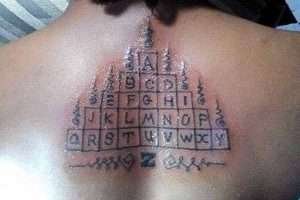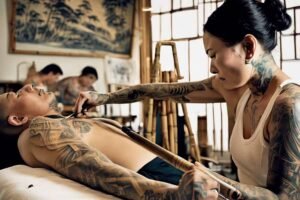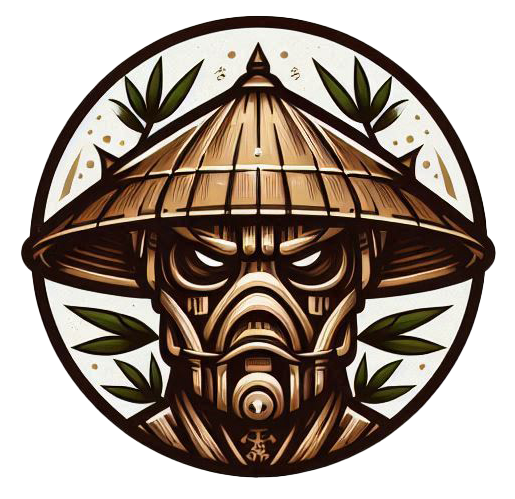Bamboo Tattoo FAQ (Frequently Asked Questions)
Bamboo Tattoo FAQ. Frequently Asked Questions (and Answers) about Thailands Bamboo Tattoos.
Welcome to the ultimate Bamboo Tattoo FAQ, your go-to resource for everything related to knowing the difference between a Bamboo Tattoo vs Traditional Thai Tattoo vs Sak Yant. Whether you’re curious about the ancient techniques, wondering about pain levels, healing times, or how bamboo tattoos compare to machine tattoos, we’ve got you covered.
Our comprehensive guide answers the most common questions about bamboo tattooing, its cultural significance, safety, and aftercare. If you’re planning to get an authentic Sak Yant from a trained practitioner or just exploring the art form known as Bamboo Tattoo, this FAQ page will help you make an informed decision. Discover the beauty and lack of spiritual meaning behind bamboo tattoos, and their non existent myth of being rooted in Thai tradition Tattooing.
Thailand’s Bamboo Tattoos (using a Bamboo Needle and the Hand Poke style) is a modern marketing gimmick that developed about 20 years ago. A bamboo tattoo is a modern tourist driven system of applying tattoos that suggest a non existent connection with the traditional tattooing (Sak Yant) because the application method (hand poke) are the same. In reality there is no mention in Thailands Academic or historical records of ever using bamboo before tourist started requesting it, and Tattoo Shop Websites started making up pages to define the Bamboo Tattoo.
The Bamboo Tattoo actually post dates modern tattoo machines use in Thailand, with most ‘Bamboo tattoo Artists’ starting after 2003. Bamboo Tattooing is falsely associated with a cultural significance in Thailand, using connections to the Sak Yant Tattoo created by a trained and qualified master.
While the Bamboo Tattoo ‘Art-form’ is relativity recent, it is a misleading marketing technique (as Thailands tattoo artists do NOT actually use a Bamboo Needle). The Bamboo Tattoo system has become a popular way tourists in Thailand think about and receive a tattoo; but should not be confused with the real traditional Thai tattoo called a Sak Yant which also uses the hand poke method. (see next Question)
Not at all. A bamboo tattoo refers to the technique used (manual hand-poking), whereas a Sak Yant tattoo refers to the type and meaning of the design sacred geometric patterns and scripts believed to offer protection, blessings, or power. Most Sak Yant tattoos are done using the Hand poke traditional method using a steel rod and needle by a spiritual practitioner called an Ajarn or Buddhist monk.
Confusing arises (and is encouraged) when someone confuses the modern bamboo Tattooing with the traditional approach because the Bamboo Tattoo also uses a hand poke method in it’s application.
However, bamboo tattoos are not Sak Yant; some Bamboo Tattoos may replicate fake Sak Yant designs as a decorative or modern artistic take applied using the same traditional hand poke technique. Without an understanding of the ancient magical languages, a Tattoo artist can not make a sacred and spiritual Sak Yant and the Bamboo Tattoo is a non spiritual replica devoid of any meaning.
Pain tolerance varies from person to person, but many people report that bamboo tattoos are less painful than machine tattoos. This is because the needle doesn’t tear the skin the way a machine’s vibrating needles do. The bamboo method is gentler and causes less trauma, leading to a sensation that feels more like light pricking or scratching rather than the burning or vibrating sensation of a machine tattoo.
However, despite what some tattoo artists will claim that it does not hurt and heals very quickly – a Bamboo Tattoo is a Tattoo; and tattoos hurt .
Bamboo tattoos usually heal faster than machine tattoos. The hand-tapping method is less invasive and doesn’t cause as much scabbing or bleeding. Typically, the surface of the tattoo heals within 3 to 7 days, with full healing complete in about 1 week.
Proper aftercare is still crucial, cleaning the area, applying gentle ointments, and avoiding sun and water exposure for at least 3 Days will ensure optimal healing and color retention
Yes, bamboo tattoos are safe when done by a skilled and hygienic artist. The process itself is not unsafe, but sanitation and sterilization are vital. Reputable tattoo artists and Ajarns use sterilized needles (often disposable) and clean ink pots. Always research the studio or master, and don’t be afraid to ask about their health and safety protocols.
One myth that tattoo Artists and Studio websites like to push is that the Replica Sak Yant Designs they make are safer than risking unhygienic practices by Sak Yant Masters or Monks at Temples. This is nonsense as it assumes being spiritual also makes you an idiot and likely to ignore common sense knowledge of tattooing for the last several decades. There are no Tattoo Artists who rely on reviews in these modern times who would risk being unhygienic – not even if they are Sak Yant Masters or Monks.
Bamboo tattoos are permanent, just like machine tattoos. The ink is inserted into the dermis, the second layer of skin, where it remains for life. Some people believe bamboo tattoos fade more quickly, but this is usually due to poor aftercare or sun exposure—not the technique itself. In fact, with proper care, a bamboo tattoo can retain its clarity and sharpness for many years.
Yes, bamboo tattoos are legal in most countries, including Thailand. However, certain sacred or religious designs, such as Sak Yant, may be governed by cultural or religious restrictions. For example, Thailand has specific guidelines around sacred tattoos involving Buddha imagery. While most bamboo artists operate legally, always choose a licensed or widely respected practitioner to ensure safety and cultural respect.
Bamboo tattoos and the modern method of applying tourist tattoos using the hand poke method is only disrespectful when using the sacred Sak Yant Designs. Any other Tattoo designs can be applied with the Bamboo Tattoo method without any cultural issue. You should however be aware that if the bamboo Tattoo Artist you are using also creates the fake sacred Sak Yant designs … then while the bamboo tattoo you get is not disrespectful – you are getting it from an artist who does not respect their own culture.
Yes for non sacred Sak Yant designs. While bamboo tattoos are often associated with traditional patterns like Sak Yant or tribal designs, many artists offer custom artwork. You can request names, symbols, mandalas, or even contemporary images done using the bamboo technique.
However, if you’re receiving a spiritual tattoo from an Ajarn, the design might have restrictions on the location of where it can be placed. These restrictions are not followed with a Bamboo tattoo Artist replica as they hold no spiritual or significant meaning.
The Bamboo Needle is a myth, and has never been used to apply any tattoos in Thailand. The Bamboo Needle is considered as a marketing concept when modern Tattoo artists received tourist requests for Sak Yant designs using the traditional method. Angelina Jolies Sak Yant was incorrectly reported in western media as being a bamboo tattoo using a bamboo needle.
The myth of a Bamboo Needle is discussed on many Sak Yant websites and is common knowledge among real Sak Yant Masters. However every Tattoo Artist website who rely on the commercialization of this myth will talk about Bamboo Needles being used in the Past.
Traditionally, the bamboo handle may be reused, but the needle tip should always be new or thoroughly sterilized. Many modern bamboo artists use stainless steel tips or disposable needles attached to the bamboo shaft. It’s essential to confirm this with your artist before getting tattooed. Reputable practitioners will prioritize hygiene and not compromise client safety.
No one uses Bamboo Needles, so there is no issue ever finding them being reused.
Bamboo tattoos can appear softer and more organic, with a hand-crafted look, especially in fine-line or dotwork styles. They may not be as bold initially as machine tattoos, but they settle beautifully into the skin over time. The level of detail and clarity largely depends on the artist’s skill. A well-done bamboo tattoo can look just as clean and professional as one done with a machine.
Traditionally, bamboo tattoos use only black or red ink, especially for Sak Yant and other spiritual designs. However, some modern bamboo artists have begun experimenting with colored inks, though it’s less common. Because the ink is hand-poked, color blending is more difficult than with machines, and the final result may look different. Always consult with the artist if you’re considering color
Yes, one of the advantages of bamboo tattoos is that the technique causes less trauma to the skin. As a result, there is usually minimal bleeding, swelling, or scabbing. This leads to a faster, more comfortable healing process and fewer complications like infections or scar tissue. Many people are surprised by how clean and calm their skin looks just a few hours after getting a bamboo tattoo.
Yes, anyone can receive a bamboo tattoo in Thailand, Any non sacred design done by a tattoo artist using the hand poke method can be done without any issues.
But Sak Yant tattoos which carry spiritual meaning—are traditionally reserved for those who show respect and intent. Ajarns require a small ceremony, a wai (respectful bow), and provide a blessing afterwards. It’s important to approach the process with humility and cultural sensitivity. In contrast, decorative bamboo tattoos are available in tattoo shops for anyone.
Not necessarily. Prices vary depending on the artist’s reputation, the size and complexity of the design, and the time required. Some bamboo tattoos may cost more due to the manual nature of the work and the skill involved.
Sak Yant tattoos done by monks or Ajarns are usually cheaper than a commercial tattoo artists
Aftercare is crucial. Keep the tattoo clean and dry for the first 24 hours. Gently wash with antibacterial soap and avoid soaking it. Apply a light, unscented healing balm (like Bepanthen or a tattoo-specific aftercare product) for several days. Avoid sun, swimming, and scratching. Bamboo tattoos heal faster, but following proper aftercare ensures long-lasting results and prevents fading or infection
Thailands Bamboo Tattoos are a recent (but now very common) trend in Thailand tattooing circles that replicate the traditional style of hand poked Sak Yants that are done by holy men in Thailand. Bamboo was never used by these holymen who had access to steel for thousands of years, however international media misinformation coined the term Bamboo Tattoos and Thailands tattoo artists run with the new trend from tourists demand.
You can read here to find out the real (and recent) History of Bamboo Tattoos
Absolutely. Many people mix both techniques across their body. A bamboo tattoo can be placed beside or even over existing machine tattoos to enhance or complement them. Just be sure your artist understands the contrast in style and ink saturation, so the final result is cohesive.
Almost all Bamboo tattoo Artists will have reviews and photos of their work available in google Maps and social media applications.
The largest guide regarding the ethics is if the bamboo tattoo Artists either avoids making fake Sak Yant designs or clearly explains they only make replica artistic copies without any meaning (usually even the text is gobble-gook). If the bamboo tattoo artists attempts to display or mention a relationship with their bamboo tattoos and real Sak Yants – avoid them. If the artist is prepared to be disrespectful to their own culture, you can not expect them to value a customer who is going to soon leave and not be seen again.
A genuine Ajarn is a qualified Sak Yant master, often with a background in Buddhist monkhood or spiritual training, who has been passed down traditional knowledge and authorized to give Sak Yant tattoos. While it’s a common myth that real Ajarns only accept donations, most legitimate Ajarns today have fixed prices, especially those who work with foreigners. This pricing helps maintain order and fairness, and it does not disqualify their authenticity.
To identify a real Ajarn, look for:
A clean, respectful environment with spiritual decor (shrines, yantras, images of teachers or monks).
A deep knowledge of Sak Yant meanings, mantras, and rituals.
A clear lineage or history of spiritual training.
The inclusion of a chanting or blessing ritual after the tattoo is completed.
Fake or commercialized “Ajarns” may rush the process, skip the blessing, lack knowledge of the tattoo meanings, don’t change the incorrect script in the templates used or treat the tattoo as just body art. You can read more on How to avoid getting a Fake Sak Yant and how to Spot Fake Sak Yant masters
No, not immediately. Swimming—especially in oceans, pools, or lakes—can introduce bacteria and lead to infection. You should wait at least 3 days before exposing a fresh bamboo tattoo to water, and only after the top layer of skin has healed. Until then, avoid soaking the tattoo and rinse gently with clean water if needed. Saltwater and chlorine can damage the tattoo and delay healing.
Not necessarily. While bamboo tattoos may appear lighter at first due to the more delicate application, they are just as permanent. With proper aftercare and protection from sun exposure, they can last just as long as machine tattoos. If your tattoo fades prematurely, it’s usually due to sunlight, poor healing, or friction—not the bamboo technique itself.
Bamboo Tattoo Articles
- All
- Bamboo Tattoo
- Sak Yant Tattoo
- Tattoo Shop

What is a Bamboo Tattoo? What is a Bamboo Tattoo? | Meaning of Bamboo Tattoos Thailands Bamboo Tattoos are a...

Why you don’t get a Tattoo Artist Sak Yant Why you don’t get a Tattoo Artist Sak Yant Bamboo Needle...

Biggest Thailand Tourist Scam – Fake Sak Yant Bamboo Tattoo While not that well known or at all reported, one...

What to Do After Getting a Fake Sak Yant Receiving a Sak Yant tattoo is often considered a sacred and...

How to Avoid getting Fake Sak Yants Tattoo Shops in Thailand and regular Tattoo Artists can’t do real Sak Yant...

Traditional Thai Tattoo vs Bamboo Tattoo (non-existent in Thai Culture) Western media made up the term Bamboo Tattoos when reporting...
